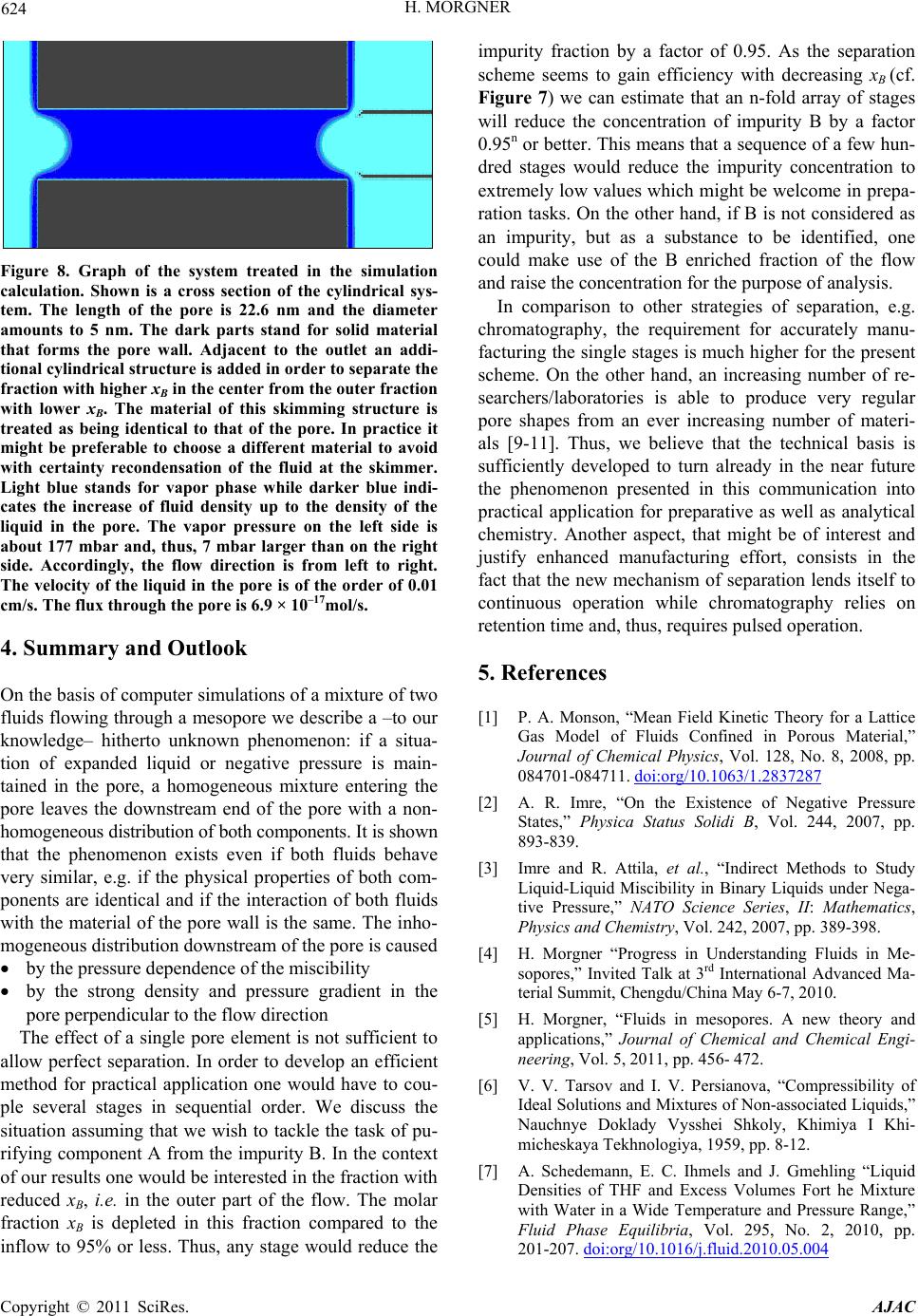
624 H. MORGNER
Figure 8. Graph of the system treated in the simulation
calculation. Shown is a cross section of the cylindrical sys-
tem. The length of the pore is 22.6 nm and the diameter
amounts to 5 nm. The dark parts stand for solid material
that forms the pore wall. Adjacent to the outlet an addi-
tional cylindrical structure is added in order to separate the
fraction with higher xB in the center from the outer fraction
with lower xB. The material of this skimming structure is
treated as being identical to that of the pore. In practice it
might be preferable to choose a different material to avoid
with certainty recondensation of the fluid at the skimmer.
Light blue stands for vapor phase while darker blue indi-
cates the increase of fluid density up to the density of the
liquid in the pore. The vapor pressure on the left side is
about 177 mbar and, thus, 7 mbar larger than on the right
side. Accordingly, the flow direction is from left to right.
The velocity of the liquid in the pore is of the order of 0.01
cm/s. The flux through the pore is 6.9 × 10–17mol/s.
4. Summary and Outlook
On the basis of computer simulations of a mixture of two
fluids flowing through a mesopore we describe a –to our
knowledge– hitherto unknown phenomenon: if a situa-
tion of expanded liquid or negative pressure is main-
tained in the pore, a homogeneous mixture entering the
pore leaves the downstream end of the pore with a non-
homogeneous distribution of both components. It is shown
that the phenomenon exists even if both fluids behave
very similar, e.g. if the physical properties of both com-
ponents are identical and if the interaction of both fluids
with the material of the pore wall is the same. The inho-
mogeneous distribution downstream of the pore is caused
by the pressure dependence of the miscibility
by the strong density and pressure gradient in the
pore perpendicular to the flow direction
The effect of a single pore element is not sufficient to
allow perfect separation. In order to develop an efficient
method for practical application one would have to cou-
ple several stages in sequential order. We discuss the
situation assuming that we wish to tackle the task of pu-
rifying component A from the impurity B. In the context
of our results one would be interested in the fraction with
reduced xB, i.e. in the outer part of the flow. The molar
fraction xB is depleted in this fraction compared to the
inflow to 95% or less. Thus, any stage would reduce the
impurity fraction by a factor of 0.95. As the separation
scheme seems to gain efficiency with decreasing xB (cf.
Figure 7) we can estimate that an n-fold array of stages
will reduce the concentration of impurity B by a factor
0.95n or better. This means that a sequence of a few hun-
dred stages would reduce the impurity concentration to
extremely low values which might be welcome in prepa-
ration tasks. On the other hand, if B is not considered as
an impurity, but as a substance to be identified, one
could make use of the B enriched fraction of the flow
and raise the concentration for the purpose of analysis.
In comparison to other strategies of separation, e.g.
chromatography, the requirement for accurately manu-
facturing the single stages is much higher for the present
scheme. On the other hand, an increasing number of re-
searchers/laboratories is able to produce very regular
pore shapes from an ever increasing number of materi-
als [9-11]. Thus, we believe that the technical basis is
sufficiently developed to turn already in the near future
the phenomenon presented in this communication into
practical application for preparative as well as analytical
chemistry. Another aspect, that might be of interest and
justify enhanced manufacturing effort, consists in the
fact that the new mechanism of separation lends itself to
continuous operation while chromatography relies on
retention time and, thus, requires pulsed operation.
5. References
[1] P. A. Monson, “Mean Field Kinetic Theory for a Lattice
Gas Model of Fluids Confined in Porous Material,”
Journal of Chemical Physics, Vol. 128, No. 8, 2008, pp.
084701-084711. doi:org/10.1063/1.2837287
[2] A. R. Imre, “On the Existence of Negative Pressure
States,” Physica Status Solidi B, Vol. 244, 2007, pp.
893-839.
[3] Imre and R. Attila, et al., “Indirect Methods to Study
Liquid-Liquid Miscibility in Binary Liquids under Nega-
tive Pressure,” NATO Science Series, II: Mathematics,
Physics and Chemistry, Vol. 242, 2007, pp. 389-398.
[4] H. Morgner “Progress in Understanding Fluids in Me-
sopores,” Invited Talk at 3rd International Advanced Ma-
terial Summit, Chengdu/China May 6-7, 2010.
[5] H. Morgner, “Fluids in mesopores. A new theory and
applications,” Journal of Chemical and Chemical Engi-
neering, Vol. 5, 2011, pp. 456- 472.
[6] V. V. Tarsov and I. V. Persianova, “Compressibility of
Ideal Solutions and Mixtures of Non-associated Liquids,”
Nauchnye Doklady Vysshei Shkoly, Khimiya I Khi-
micheskaya Tekhnologiya, 1959, pp. 8-12.
[7] A. Schedemann, E. C. Ihmels and J. Gmehling “Liquid
Densities of THF and Excess Volumes Fort he Mixture
with Water in a Wide Temperature and Pressure Range,”
Fluid Phase Equilibria, Vol. 295, No. 2, 2010, pp.
201-207. doi:org/10.1016/j.fluid.2010.05.004
Copyright © 2011 SciRes. AJAC